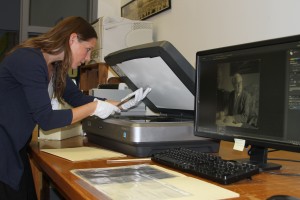 From photographs of blues legend B.B. King to the historic images of the 1962 integration of Ole Miss, the digital collections of the University of Mississippi’s Department of Archives and Special Collections are a valuable online resource.
From photographs of blues legend B.B. King to the historic images of the 1962 integration of Ole Miss, the digital collections of the University of Mississippi’s Department of Archives and Special Collections are a valuable online resource.
Archives and Special Collections staff digitizes an array of historic photographs, documents and interviews, including analog materials such as books, manuscripts, posters, maps and photographs, as well as audio and video formats such as vinyl, tapes, film reels and VHS.
Beginning in the early to mid-2000s, digitization, the process of converting various material types into digital formats, has become a standard practice in libraries, museums and similar organizations.
Aside from the Blues Photograph Collection and the Integration of the University of Mississippi, some notable digital collections include the Civil War Archive, Civil Rights Archive, Presidential Debate Collection, AICPA Historical Collection, Freedom Riders Oral Histories and University of Mississippi yearbooks.
“We have created a large amount of digital collections throughout the last decade at the University of Mississippi,” said Susan Ivey, UM digital initiatives librarian and assistant professor. “The digitization of Archives and Special Collections’ materials provides access to users that are not able to physically come to the library to use these materials.
“Digital collections also allow for new connections and links between materials to be made without the act of physically removing these materials from their original collections,” she said. “It also saves time for researchers who are able to visit the library.”
Hired as the new digital initiatives librarian last October, Ivey obtained a Master of Library Science from the University of North Carolina at Chapel Hill, where she also worked in the Digital Production Center at Wilson Special Collections Library.
At the J.D. Williams Library, Ivey’s duties go beyond simply scanning materials. Not only does she train and oversee student workers in the scanning and imaging of materials as well as the creation of metadata and online finding aids, but she also handles all the uploading of digital files into a content management system for students and other faculty members who work in the department.
Other library personnel, including the web services librarians, the ACIPA reference librarian, as well as the technical services and IT departments, are included in various other aspects of digital projects as well.
“Students and faculty regularly use our physical and digital collections, as well as researchers throughout the country and even the world,” Ivey said. “We receive requests for digitization regularly.”
Long-term preservation and sustainability of these digital files as well as the funding is a concern for the department.
“Most of the digital collections are accessible, and especially born-digital materials, is an increasing issue within libraries and museums,” Ivey said. “Just like physical materials, digital materials must be taken care of so that they can last in the future.”
With the growth of the digital library field, Archives and Special Collections aspires to stay abreast of this evolving process.
“Our library just purchased a large format overhead scanner, and we are really excited about the opportunities that this will afford us for digitization,” Ivey said. “It will provide us the means to digitize larger materials and bound materials in-house, rather than relying on outside vendors.”
“We do, however, still have additional equipment and staffing needs for digitization, including additional server space, various type of scanners, new and ongoing software costs, and student and staff wages, to name a few,” she added.
All of the digital collections are accessible at clio.lib.olemiss.edu as well as through the Mississippi Digital Library. Several digital materials are also available through other project portals, such as the UM yearbooks through the Internet Archive, and the new Association of Southeastern Research Libraries project, which will launch early 2015 through the Digital Public Library of America website.